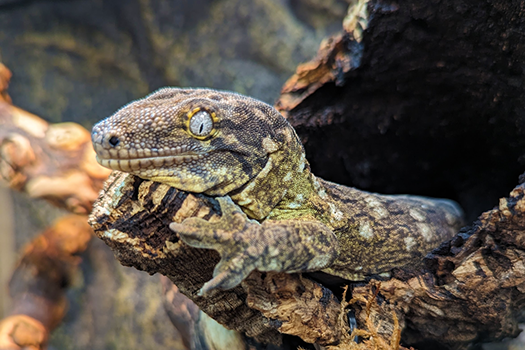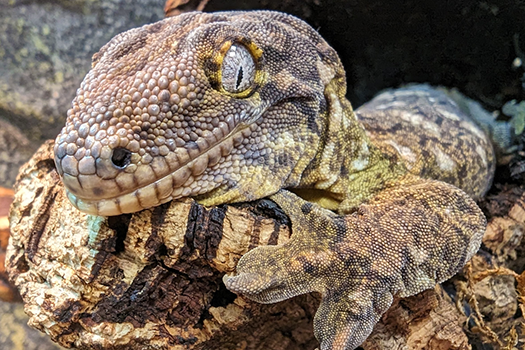Rhacodactylus leachianus | New Caledonian gecko
Name: Biscuit (Female)
Nickname: “Leachie”


The “Laechie” of the Trees
Meet Biscuit, our New Caledonian giant gecko—known lovingly by reptile enthusiasts as a “Leachie". Native to the remote island of New Caledonia and its neighboring islets in the southwest Pacific, this species holds the title of largest gecko in the world. Despite their size, Leachies are experts at blending into their surroundings, disappearing into the mossy bark and dense canopy of their forest homes.
Nocturnal Tree-Dwellers
Leachies are strictly nocturnal and arboreal, meaning they’re most active at night and spend the majority of their lives in the trees. During the day, they hide in tree hollows and thick vegetation. Once night falls, they emerge to hunt and forage. Their prehensile tails act like a fifth limb, providing balance and grip as they navigate their lofty homes. It's the perfect adaptation for life in the treetops.
Built for the Tropics
These geckos are well-adapted to New Caledonia’s warm, humid climate. Their thick, rubbery skin helps them retain moisture and provides protection from rough bark and minor abrasions. They also have specialized toe pads, called lamellae, covered in microscopic, hair-like structures called setae. This adaptation gives them incredible grip—strong enough to cling to almost any surface, even glass! To top it off, they have large claws on each toe for extra climbing support.
And here's a cool defense mechanism: like many other geckos, Leachies can drop their tails to escape predators—a process known as autotomy. Afterward, they regenerate the lost tail through a process called epimorphosis. Nature is amazing!
Giant of the Island
The New Caledonian gecko is a fascinating example of island gigantism, where isolated island species evolve to be significantly larger than their mainland relatives. Why? Fewer predators and competitors allow some species to grow much larger—or smaller (island dwarfism)—than usual.
Their size varies depending on which island they call home:
- Main island (New Caledonia): 9–12 inches long, 150–300 grams.
- Surrounding smaller islands: 14–17 inches long, 250–500 grams.
That’s one massive gecko!
Reproduction & Family Life
Relationships among Leachies can be complex. They often form pair bonds, some lasting a single breeding season, others enduring for years. Much like birds, a bonded pair will seek out a safe, unoccupied tree hollow where the female lays her eggs and the pair defends their space.
Females typically lay two eggs per clutch and can produce up to 10 clutches per year. The temperature during incubation determines the hatchlings' sex:
- ~73°F = Female
- ~85°F = Male
Loud and Legendary
It’s not just their size that makes Leachies stand out—they’re also one of the most vocal members of their family. Their range of sounds includes growling, clucking, chirping, and whistling—and they’re loud. So loud, in fact, that some locals refer to them as the “devil in the trees".
Because their vocalizations occur mostly at night, they’ve sparked local folklore. The Kanak people, indigenous to New Caledonia, have stories about these geckos clinging to people and sucking out their souls—a testament to their eerie nighttime presence.
What's on the Menu?
In the wild, Leachies are opportunistic omnivores, meaning they eat whatever’s available—ripe fruit, nectar, insects, small vertebrates, bird eggs, and even carrion (animal carcasses).
Here at the zoo, Biscuit enjoys a varied diet that mimics her wild menu. She’s fed a mix of Pangea Gecko Diet (a fruit-based commercial blend), fresh fruit, waxworms, and mealworms.
Exotic Isn’t for Everyone!
Though Biscuit isn’t always out and about for guests to see, her story sends an important message about responsible pet ownership. She came to the zoo after being surrendered by a private owner who couldn’t provide proper care. As a result, she developed Metabolic Bone Disease (MBD)—a serious condition caused by poor nutrition and lack of proper UVB exposure.
Biscuit's skeletal structure is now permanently affected, making her appear smaller and more compact than other individuals of her species. While she’s thriving under professional care, many reptiles with MBD aren't so lucky. This highlights why exotic pets aren’t for everyone. They require specialized care, proper diets, and often expensive enclosures and equipment.
If you're considering adding a New Caledonian Giant Gecko to your family, do your research to ensure you can meet their needs. They require significant time, effort, and financial investment—there are no shortcuts when it comes to responsible reptile care!
If you would like to learn more about why domestic animals are the best pets for most people, check out the Not-a-Pet campaign! And remember, if you have the knowledge and means to add a reptile to your family, adopt don’t shop! There are tons of reptiles out there waiting for the right person to care for them.
Fact Sheet
Taxonomy
Genus: Rhacodactylus | Species: leachianus |
Kingdom: Animalia | Phylum: Chordata | Class: Reptilia | Order: Squamata | Family: Diplodactylidae |
Favorite Enrichment Type
Things to climb on (such as new plants, antlers, branches, small toys), different textures, and things stuck to the glass of her enclosure.
Life Span
- In the Wild: Can live 15 to 20 years
- In Human Care: 20 to 30+ years
Diet
- In the Wild: Soft fruits, nectar, insects, small vertebrates, and occasionally carrion. Their diet varies based on seasonal availability, with a mix of plant-based foods and protein sources like small lizards or bird eggs.
- At the Zoo: Pangaea Gecko Diet, fresh fruit, waxworms, and mealworms.
Geographic Range
Southern and eastern New Caledonia, as well as several smaller islands surrounding it. These islands can be found in the southwest Pacific.
Habitat
They inhabit the humid forests of New Caledonia, where they are primarily arboreal, living in tree hollows and dense vegetation.
Fun facts about New Caledonian giant gecko
- Native to: New Caledonia and nearby islands (Southwest Pacific).
- Activity: Nocturnal (active at night).
- Special Features: include their prehensile tail, lamellae-covered toe pads for climbing (can stick to glass), can drop and regrow tail (autotomy and epimorphosis), and thick, moisture-retaining skin.
- Vocalizations: Growls, chirps, clucks, whistles—known as the most vocal gecko species!
- Conservation Status: Least Concern—but threatened by habitat loss and illegal pet trade.
- Fun Folklore: Called the “devil in the trees” due to eerie nocturnal sounds!
Status: Least Concern
Conservation Matters
Biscuit doesn’t just educate guests about pet care—she’s also a powerful ambassador for her species. Through up-close encounters, she helps visitors understand island biodiversity, the importance of reptiles, and how even lesser-known species play a big role in their ecosystems.
Although classified as Least Concern, New Caledonian geckos face threats from habitat destruction, invasive species, and the illegal pet trade. Their limited range makes them especially vulnerable to environmental changes.
Fortunately, AZA-accredited zoos and aquariums support responsible breeding programs and conservation education efforts that reduce the demand for wild-caught animals and protect fragile island ecosystems.
In Biscuit’s world, every branch tells a story—and every chirp reminds us why even the smallest creatures deserve our respect.
How to Find Me
Biscuit is a member of our Ambassador Animals that live behind the scenes! If you would like to meet Biscuit in person, check out our daily, 11:00am Amphitheater Presentations at the Awareness Amphitheater, located just beyond the covered bridge. Amphitheater Presentations are dependent on the weather. Please check our activity board, behind the Admissions booth, before coming to see us!
